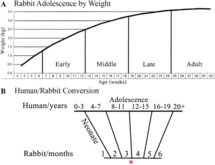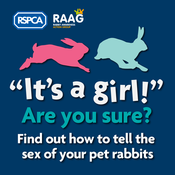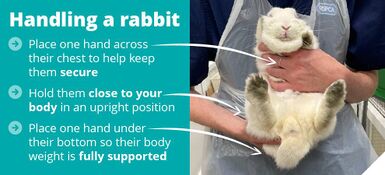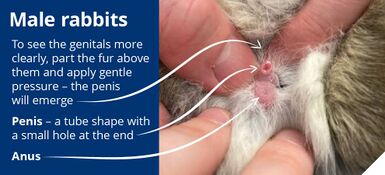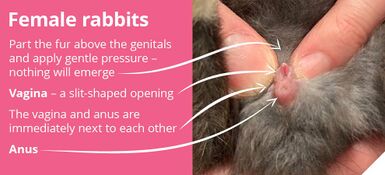Baby rabbits (domestic)
Baby rabbits should not be removed from their mother until at least 8 weeks in order for them to develop a proper digestive and immune system from their mother's milk and cecals.[1] If you bought a baby rabbit that still needs to be fed milk, be warned that your bunny may not have a good chance of survival without extreme care. Please do not purchase any rabbits under 8 weeks of age from a pet store or breeder. Selling rabbits under 8 weeks is illegal in many US states. See Rabbit sale laws in the US for more details.
Appearance
The links below include information about the appearance of baby rabbits as they grow.
- Hillside Farm Hawaii. (2014). Baby Angora Bunnies - Watch them grow up Day by Day
- Willow Creek Farm. (2013). Baby Rabbit Growth Time Lapse Photos: Birth – 8 weeks
- Tru-Luv Rabbitry. (2009). How Should A 8 Weeks Old Look Like
- Miriam's Bunnies. (1999). Day by Day Growth of Newborn Bunnies
- The Nature Trail. Holland Lop Litters of Babies! Stories and Pictures
Some signs of development in baby rabbits:[2]
- Day 7: fur begins to grow
- Day 10: eyes open
- Day 12: ears open
- Day 18: leave the nest and begin to eat solid food
- Day 60: fully weaned and independent
How fast do baby rabbits grow?
Studies have shown that growth rates of the domestic rabbit are significantly affected by litter size and birth weight -- heavier babies grow faster than lighter ones, perhaps because they compete better for their mother's milk. Growth rates are also influenced by temperature, with babies growing faster at higher temperatures than lower ones. At lower temperatures, the babies need to devote more energy towards heat regulation instead of growth, but to complicate the relationship, babies in larger litters require less energy for thermoregulation due to their huddling behavior. A recent study by Rödel showed that babies in litters of three grew relatively faster at lower temperatures than babies in litters of two, even though more siblings were competing for milk.[3]
A baby domestic rabbit's rapid growth before weaning can be attributed to their mother's energy-rich milk that is high in both fat and protein and low in sugar. Domestic rabbit milk is 12 to 13% fat and 10 to 12% protein. To put this in perspective, domestic rabbit milk is twice as dense with fats and three times as dense in protein than cow's milk.[3]
Rabbit growth can also be dependent on breed.
- Flemish Giant rabbits are usually born about 3-4 oz, and by 8-9 weeks weigh 5 lbs. From 8 weeks to 8 months, the rabbit can gain 0.5 to 0.75 lb/week and is not considered full grown until 14 months of age.[4]
- In a study group of 29 rabbits, New Zealand white rabbits have been recorded to reach 6% of the 34-week mean body weight at 2 weeks, 72% of the 34-week weight by 16 weeks, and their weights continued to grow after 34 weeks.[5]
- Champagne D’ Argent x Palomino kits can weigh about 1-1.5 lb at 3 weeks, and by 8 weeks weigh 4 lb.[6]
Some useful terms that rabbit breeders use with regards to rabbit age:
- Junior: a rabbit under 6 months of age.
- Senior: a rabbit over 6 months of age.
- Intermediate or 6/8: A rabbit between 6-8 months of age.
Caring for baby rabbits
To distinguish various baby rabbits in the litter, you may use a dab of food coloring, felt tip pen, or xylene-free marker in the ear.[7][8] Felt tip pen markings need to be renewed weekly, and with prolonged use, rabbits may develop dermatitis in reaction to chemicals in the ink.[8] Xylene-free markers make marks which last about three weeks and are non-toxic.[8] Rabbits can also be shaved regularly in various spots to differentiate between identical markings. When the babies are older, a rabbit-experienced veterinarian can microchip the litter for permanent identification, and the carer can use a handheld scanner to check the identity of each rabbit.
You may handle the baby rabbits even if the mother does not know you but refrain from constantly interfering during the first few days as it increases the likelihood of maternal cannibalization.[9]:85 If you find baby rabbits outside of their nest during the first two weeks, you can pick them up and place them back inside. Sometimes, kits can be pulled out if they are still nursing when the mother rabbit jumps out. After they are around 12 to 18 days old, baby rabbits should naturally start exploring around the nest.
In general, you should not need to do anything for the baby rabbits for the first few weeks other than keeping the mother rabbit fed and happy. However, do make sure that their nest box is clean and dry at all times to prevent infection. If an area inside the nest is dirty or damp, it can be spot cleaned by removing the material and replacing it with fresh material. The nest box can be removed after the babies are 18 days old.
If you want proof that the babies are properly being taken care of by their mother, check them once early each morning. They should be warm and round-bellied from their feeding and burrowed and hidden at the bottom of the nest until mealtime. Baby rabbits that are not being fed will be restless, crawling around on the surface of the nest, and take on a wrinkled appearance due to dehydration.[9]:85 The best way to confirm that they are being taken care of is to weigh them on a small postage scale or kitchen scale and track their weight. If they are gaining weight (~1/4 oz), the babies are being fed.[10]
Generally, male rabbits will be tolerant of baby rabbits and can remain with the babies if he has been neutered for at least a month. The father will begin to nip and play roughly with the sons as they begin to reach puberty and start acting feisty, and the father rabbit should then be separated.[10] If the father rabbit has not been neutered for over 6 weeks, he should not be in contact with the mother as she can get pregnant again immediately after giving birth.
To raise rabbits that are more willing to approach humans and remain closer to them, a study suggests that baby rabbits between the age of 26 and 42 days should be picked up and handled.[9]:93
See Taking care of a pregnant rabbit and her litter for more information.
For information on how to take care of baby rabbits after they have been weaned, please see the articles Getting started with a rabbit and Diet.
Weaning baby rabbits
Baby rabbits are completely dependent on milk until day 10 and usually eating small amounts of solid food by day 15. They may start leaving the nest and begin to be weaned naturally around 25 days of age.[9]
However, baby rabbits should not be completely weaned from their mothers and sold until 8 weeks of age. Babies removed earlier have a high risk of developing enteritis, which is easily fatal in a young rabbit.
To wean the babies, you can start by keeping all the kits in one cage and leaving the mother in a separate area. Leaving the kits together will lessen the stress of being removed from their mother. After a week, the kits can then be separated into their own cages to prevent mating and producing more babies.
The pancreas of the rabbit is not fully developed until around eight weeks, and pancreatic enzymes normally digest starch in the small intestine.[4] High amounts of rapidly digestible sugars and starch in the diet of young rabbits may cause an overload of cecal bacteria, some of which may produce toxins.[4] Pathogens such as Clostridium spiroforme and Escherichia coli can proliferate, colonize the GI tract, and produce iota toxins that are often lethal to kits at 14-20% rates of mortality.[4]
Below are links with more information about the process and age of weaning.
- van Praag, E. E.coli and the protective role of Lactobacillus casi in newborn rabbits
- American Rabbit Breeders Association. When can I sell or wean my rabbits?
- Golden Pines Rabbitry. Weaning young rabbits
Orphaned baby domestic rabbits
Rabbit kits may need to be hand-reared in case of maternal death or mismothering or lactational failure of the doe. Does with a new litter may take 24 hours to start lactation.[11] Mother rabbits only jump in the nest twice a day (once early in the morning and once in the evening) for about five minutes at a time to nurse their young, and do not "nest" on their litter of rabbits.[12] See Nursing process for more information.
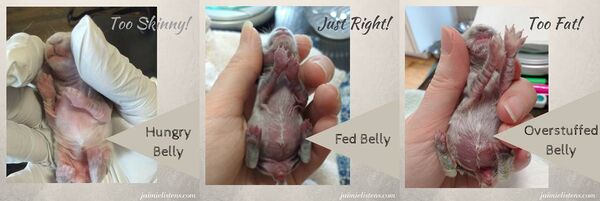
Mismothering can be diagnosed if the kits have not been fed for 48 hours.[11] Unfed kits will have thin abdomens and wrinkled skin due to dehydration. From Dana Krempels,[13]
If the mama has been separated from the babies for more than 24 hours, and refuses to feed them, you can try to gently, but firmly hold her over the babies until they can get a meal. Stroke the mama, talk to her gently and love her, making her feel secure. After the first feeding, you probably won't have to do this again. She will take care of the babies on her own.
Before handling the babies, wash your hands well with disinfectant soap and hot water. Once they're clean, rub your hands in a bit of clean, fresh hay and on mama's fur to scent your hands.
The most common causes of failure and death when hand-rearing rabbits are aspiration pneumonia due to inhalation of milk into the lungs, and diarrhea due to the failure to establish a normal gut flora.[11] Death at around four weeks of age are also common due to enteritis from intestinal Escherichia coli overgrowth.[11]
How do I keep the babies warm?
Kits under 7 days old should be kept at 27-30°C (80.6-86.0°F).[11] A incubator, heated cage, or airing cupboard can be used to house the babies. The kits should be placed in a box lined with hay, maternal fur if available, or soft cloths and fleece. The nest box should be in a quiet place at ground level where other pets and children are not allowed until the babies are eating solid food and out of the nest. For the first few days, keep the room relatively dimly lit and quiet. The temperature can be lowered after seven days if the kits are thriving.[11] Do not use an electric heating pad. From Dana Krempels,[13]
Two or more babies usually are able to snuggle and keep each other warm if they have a good, padded nest. If there's only one baby, a warm water bottle wrapped in a soft towel can provide an excellent artificial heat source, but be sure the baby can crawl away from the bottle if it feels too warm.
If the baby rabbit's body temperature drops less than 97°F (36°C), it can be warmed by immersing it in a warm (100°F [37.8°C]) bath and gently massaging it while keeping its head above the water.[14]

How do I feed orphaned baby rabbits?
Ideally, try to find a nearby rabbit breeder or rescue that may have a lactating doe that will be able to foster the baby rabbits. There is no perfect replacement for a rabbit's milk. Females do not make any distinction of young, even if they are of different colors and sizes. Ideally, older rabbits should be introduced to a younger litter, and the fostered babies should be place at the bottom of the nest with the natural kits on top.[9]:85
To foster kits into another litter, the litters should be within a few days of each other. First, distract the doe that will be taking on the new kits with a treat or toy that will keep her busy. Then, take the kits that need to be fostered and rub them with the fur inside the existing nest before rearranging the new and old kits in a nice group around each other. The new kits will then take on the smell of the fur and existing kits, allowing the mother rabbit to accept them without too much issue.
Otherwise, some tips on hand-rearing' and feeding orphaned baby rabbits:
- Infants lose the suckling instinct quickly, so if hand feeding is to be attempted, it must be started within 48 hours. Kitten nursers are much too large for the mouth of a baby rabbit. Toy doll bottles are sometimes small enough. If the baby has lost the suckling instinct, a tuberculin syringe (with needle removed) can be used to carefully administer formula.[15] Healthy babies should suck the milk out of syringe. Squirting milk into the mouth increases the risk of choking and fatal aspiration pneumonia.[9]:85
- Use boiled water and sterile syringes and feeding tubes and make each feed immediately prior to it being given to reduce the chances of fatal enteritis from bacterial infection.[9]:86
- Feed only twice a day. Overfeeding is a leading cause of death in these youngsters which results in fatal intestinal disease.[12] Do not allow a baby rabbit overfeed at one sitting![13] A baby can learn suckle so quickly that it is possible for him to ingest a volume too great for his stomach. Although it is unlikely for the stomach to rupture, stretching it too taut can cause pain, gas, and make the baby sick. It is better to underfeed slightly than overfeed. If in doubt, let the baby rest for about a minute after feeding to allow time for the stretch receptors to respond and let the baby know he's really full, then offer the nipple again.
Orphaned baby rabbits will need help defecating/urinating after each feeding as they are unable to on their own.[12][13] Usually the mother will groom the babies to do so.
To simulate this, use a cotton ball moistened with warm water and gently stroke the anal area until the bunny starts to produce feces and urine. Stop only when the output stops. You may wish to first place a towel on your lap before doing this procedure as it can be very messy.
WARNING: Failure to stimulate the babies to urinate/defecate can result in the death of the baby. The bladder can actually rupture if it is not stimulated to empty. It may take a couple of weeks before the babies are able to urinate and defecate on their own. Watch for signs of redness/irritation around the anus and urethral opening, which can indicate that you are stimulating too vigorously. Back off on the pressure, and apply a bit of soothing calendula ointment (available at health food stores) to heal the irritation.If the feces come out liquid or "smeary", it's a sign of potentially serious trouble. Consult your rabbit-experienced veterinarian at the first sign of diarrhea, as this can be fatal in only a few hours in a baby rabbit.
Generally, this procedure is no longer necessary after 1 week of growth.[14]
- If possible, obtain adult cecotropes to feed to the babies after their eyes are open. Usually, the babies will eat the cecotropes immediately, because it the natural thing for them to do. However, if the babies do not eat the cecotropes on their own, add two to three of the individual pellets in the cluster to the formula at one feeding per day for three to four days.[15]
Amount to feed
The amount of formula to feed will depend on the age and size of the baby rabbit.[12][13] The following guidelines are for twice daily feedings for a baby rabbit that will be about five pounds as an adult. 1 cc is equivalent to 1 mL.
- Newborn to One Week: 2-2.5 cc each feeding.
- 1-2 weeks: 5-7 cc each feeding. Amount will vary depending on size of rabbit. Smaller rabbits will need less.
- 2-3 weeks: 7-13 cc each feeding. Domestic baby rabbit eyes open at about 10 days of age. You can start introducing them to hay, alfalfa pellets, and water.[12] Although they may begin to eat solids, this does not mean that they should be or are ready to be weaned.
- 3-6 weeks: 13-15 cc each feeding.
- 6-8 weeks: The babies should start to wean at this period. Begin to dilute the formula from 3:1 formula:water, gradually adding more and more water until the babies lose interest.
Formula recipes
For all formulas, heat the formula to about 105°F and keep it warm in a water bath while you feed the babies. They are generally more eager to accept warm formula.[13] Prepare enough milk replacer daily to allow for one day of feeding and keep it refrigerated between feeds.[14]
A few specially formulated milk replacers designed to be nutritionally complete for baby rabbits:
From Dana Krempels, Ph.D.,[13]
- 1/2 cup of fresh whole goat milk
- 1/2 cup of Kitten Milk Replacer (KMR) by PetAg
- 10 capsules/1-1.5 Tbsp of lyophilized (freeze dried) colostrum - available at most high-quality health stores either in bulk powder form or capsules. Colostrum is a special, immunoglobin-rich substance with antibodies that help destroy foreign bacteria that the mother rabbit produces in the first few days of lactation. Without a colostrum "starter", the babies have a lower chance of survival.
- 3 cc of heavy cream
Mix ingredients together in a lidded container, and shake very well until colostrum is dissolved. It's best to mix this a few hours in advance so that the colostrum has time to soften and suspend easily.
The House Rabbit Society recommends adding a pinch of acidophilus to promote healthy gut flora.[12] They also recommend not using any cow's milk, puppy formula, or Karo syrup.
From Ferrets, Rabbits, and Rodents, Clinical Medicine and Surgery, 3e, [14]
Cheeke's Milk Replacer
- 1/2 cup of evaporated milk
- 1/2 cup of water
- 1 egg yolk
- 1 Tbsp of corn syrup
Taylor's Milk Replacer 1
- 1/2 cup of Esbilac powder
- 1/8 cup of heavy cream
- 1/2 cup of water
Taylor's Milk Replacer 2
- 1 cup of KMR liquid
- 1/2 cup of Multi-Milk powder
Taylor's Milk Replacer 3
- 1 cup of Esbilac
- 2/3 cup of Multi-Milk powder
Taylor's Milk Replacer 4
- 1 cup of Esbilac
- 1 cup of Multi-Milk powder
- 1.5 cup of water
From Sarah Cuthill, [16]
- 1/2 cup canned evaporated goat's milk
- 1 egg yolk
- 1/2 Tbsp cane syrup
Experiences
- Karen Wilson. (2023). August 2022 Newsletter > The Tale of Unwanted Bunnies
Extra resources
The following links contain more information on how to care for orphaned baby rabbits.
- Jaimie Listens. (2017). How to Bottle Feed Orphaned Baby Rabbits with Formula Recipe
- Sandi Koi. Domestic Baby Bunnies and Their Mom > Feeding Orphaned Baby Rabbits
- CottonTails Rabbit & Guinea Pig Rescue. HAND REARING of Rabbits
- Dana Krempels, Ph.D. Care and Feeding of Orphaned Domestic Rabbits
- Zooh Corner. How to Care for Newborn Baby Rabbits
- Rabbit Meadows. Baby Bunnies - How to care for Orphans
- Pamela Alley. (2003). Bottle Feeding Kits
- Angie Fenton. (2002). Hand Rearing a baby DOMESTIC Rabbit
Sexing
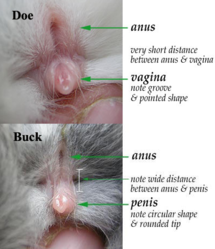
Sexing young rabbits can be very difficult for inexperienced people, but here are some guides, some with pictures, on how to properly sex your rabbit. Refer to your rabbit-savvy veterinarian for the final judgement of your rabbit's sex.
- House Rabbit Network. (2004). How to Sex Your Rabbits
- Pet Informed. (2009). Veterinary Advice Online - Sexing Rabbits (Rabbit Gender Determination).
- peteducation.com. Sexing Rabbits
- Krempels, D. How Can I Determine My Rabbit's Sex?
Here are some videos on sexing rabbits:
RSPCA
The RSPCA (Royal Society for the Prevention of Cruelty to Animals) has a great page on sexing a rabbit. Visit their page for more information. If you're still not sure whether your rabbits are male or female, or if you want advice on how to handle your rabbits, please talk to your vet. Below are the key bullet points:
The following are pages from rabbit breeder sites. As we constantly remind, we do not condone rabbit breeding for the common owner, and these have been linked for information purposes only.
- Debmark Rabbit Education Resource. (1999). Sexing Rabbits
- Rudolph's Rabbit Ranch. (2012). Brief Photographic Essay on Sexing Young Rabbits
See also
- Deciding on a rabbit
- Getting started with a rabbit
- Pregnant rabbits
- Spaying and neutering rabbits
- Understanding your rabbit
- Wild rabbits
References
- ↑ Dana Krempels, Ph.D., The Mystery of Rabbit Poop
- ↑ Richardson, V.C.G. (2000). Rabbits: Health, Husbandry and Diseases.
- ↑ 3.0 3.1 Lumpkin, S & Seidensticker, J. (2011). Rabbits: The Animal Answer Guide.
- ↑ 4.0 4.1 4.2 4.3 Moore, L. (2013). Rabbit Nutrition and Nutritional Healing. (2nd ed.).
- ↑ PubMed.gov, A longitudinal study of the growth of the New Zealand white rabbit: cumulative and biweekly incremental growth rates for body length, body weight, femoral length, and tibial length. Accessed Aug 28, 2015.
- ↑ Willow Creek Farm, Baby Rabbit Growth Time Lapse Photos: Birth – 8 weeks. Accessed Jan 29, 2016.
- ↑ Rabbit Talk. (2011). Identification marking for rabbits. Retrieved 14 March 2016 from http://rabbittalk.com/topic8412.html
- ↑ 8.0 8.1 8.2 Wildpro. (n.d.). Mammal Identification. Retrieved 14 March 2016 from http://wildpro.twycrosszoo.org/S/00Man/MammalHusbandryTechniques/Mammal_Id.htm
- ↑ 9.0 9.1 9.2 9.3 9.4 9.5 9.6 Varga, M. (2013). Textbook of rabbit medicine. (2nd ed.).
- ↑ 10.0 10.1 House Rabbit Society. (1997). Newborn Baby Bunny Facts. Retrieved 14 March 2016 from http://www.rabbit.org/care/newborn.html
- ↑ 11.0 11.1 11.2 11.3 11.4 11.5 Keeble, E & Meredith, A. (2006). Rabbit Medicine & Surgery: Self-Assessment Color Review.
- ↑ 12.0 12.1 12.2 12.3 12.4 12.5 House Rabbit Society, Caring for Orphans
- ↑ 13.0 13.1 13.2 13.3 13.4 13.5 13.6 Dana Krempels. (n.d.). Care and Feeding of Orphaned Domestic Rabbits. Retrieved 17 Feb 2014 from http://www.bio.miami.edu/hare/orphan.html
- ↑ 14.0 14.1 14.2 14.3 Quesenberry, K & Carpenter, J. (2012). Ferrets, Rabbits, and Rodents: Clinical Medicine and Surgery. (3rd ed.).
- ↑ 15.0 15.1 House Rabbit Society, Sandi Koi, Domestic Baby Bunnies and Their Mom > Feeding Orphaned Baby Rabbits
- ↑ Sarah Cuthill. (2013). How to Hand-Feed Rabbit Kits. Retrieved 18 Feb 2014 from http://www.motherearthnews.com/homesteading-and-livestock/how-to-hand-feed-rabbit-zbcz1304zcut.aspx



